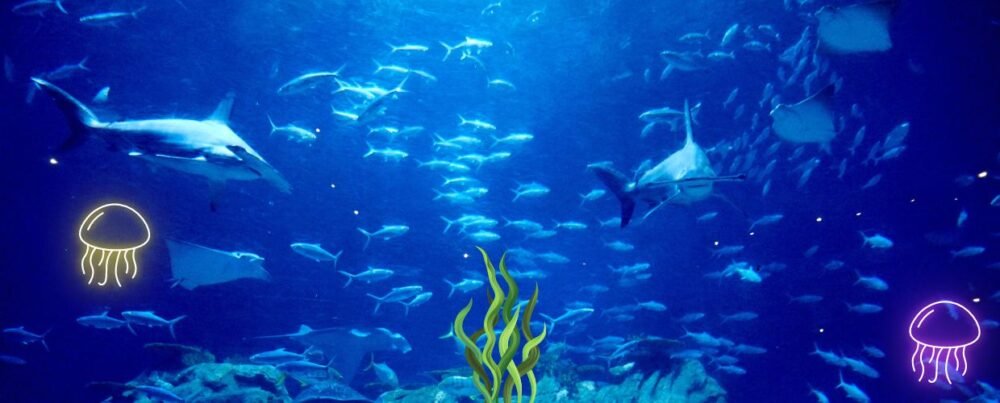The world’s aquatic environments, from the vast oceans to the tranquil freshwater rivers and lakes, host a remarkable diversity of life. Aquatic ecosystems support an array of species, each adapted to its unique habitat, and collectively, they play vital roles in Earth’s biodiversity, food webs, and the health of our planet. In this article, we embark on a journey into the depths of aquatic life, exploring the significance of these ecosystems, the remarkable adaptations of aquatic organisms, and the challenges they face in an ever-changing world.
Aquatic Ecosystems: Pillars of Biodiversity
Aquatic ecosystems encompass many environments, including marine, freshwater, and brackish habitats. They cover over 70% of the Earth’s surface and support a dazzling array of life forms, from microscopic plankton to the largest animals on the planet.
Biodiversity in Aquatic Ecosystems
The sheer diversity of aquatic life is awe-inspiring. Oceans alone are home to an estimated two million known species, with countless more waiting to be discovered. Coral reefs, often called “rainforests of the sea,” boast an astounding variety of colorful fish, invertebrates, and algae. Freshwater ecosystems harbor species adapted to various conditions, from mountain streams’ swift currents to ponds and lakes’ still waters.
Aquatic biodiversity provides numerous ecosystem services. These ecosystems are crucial for human well-being and the planet’s health, from purifying water and cycling nutrients to supporting fisheries and tourism.
The Importance of Phytoplankton
Phytoplankton are microscopic plants that drift near the surface of oceans and freshwater bodies. They are the foundation of aquatic food webs. They harness sunlight through photosynthesis, converting it into energy and oxygen. Phytoplankton’s productivity sustains countless aquatic species and influences the global climate by absorbing carbon dioxide and releasing oxygen.
Phytoplankton’s significance extends to human life as well. It forms the base of marine food chains, supporting fisheries that provide a significant source of protein for billions of people worldwide. Additionally, phytoplankton’s role in carbon cycling helps mitigate climate change by sequestering ocean carbon.
Adaptations for Aquatic Life
Aquatic organisms have evolved stunning adaptations to thrive in their watery environments. These adaptations reflect life’s challenges underwater, from buoyancy control to respiration in low-oxygen conditions.
Streamlined Bodies and Swimming Techniques
Many aquatic animals, such as fish and marine mammals, have streamlined bodies that reduce water resistance and enhance swimming efficiency. Their specialized fins and tails allow precise movement control, essential for navigating currents and catching prey.
Like dolphins and whales, marine mammals have evolved efficient swimming and respiration methods. Their blowholes enable them to breathe while submerged, and they can dive to impressive depths in search of food.
Gills and Oxygen Exchange
Gills are specialized respiratory organs found in many aquatic species. They extract oxygen from dissolved oxygen in water, allowing fish and other aquatic creatures to “breathe” underwater. The structure and function of gills vary among species, reflecting their unique ecological niches and habitats.
Buoyancy Control
Buoyancy control is a crucial adaptation for aquatic life. Many marine animals, such as sharks and rays, rely on specialized organs called swim bladders or oil-filled livers to control their buoyancy and maintain their position in the water column.
Challenges and Threats to Aquatic Life
Despite their resilience and adaptability, aquatic ecosystems and their inhabitants face many challenges in the modern world.
Pollution and Habitat Destruction
Human activities, including pollution from industrial and agricultural runoff, oil spills, and plastic waste, pose significant threats to aquatic ecosystems. These pollutants harm aquatic life, disrupt food chains, and degrade water quality.
Habitat destruction, caused by coastal development, deforestation, and the alteration of river courses, impacts the health of aquatic ecosystems. Destruction of critical habitats like coral reefs, mangroves, and wetlands reduces these environments’ ability to support diverse aquatic life.
Overfishing and Illegal Fishing Practices
Overfishing and illegal, unreported, and unregulated (IUU) fishing practices have led to the depletion of fish populations and the endangerment of marine life. Unsustainable fishing practices threaten the livelihoods of coastal communities and disrupt aquatic ecosystems.
Climate Change and Ocean Acidification
Climate change and ocean acidification, driven by increased greenhouse gas emissions, pose severe threats to aquatic life. Rising sea temperatures affect species distribution and can lead to coral bleaching. Ocean acidification, resulting from growing carbon dioxide absorption by seawater, impairs marine organisms’ ability to form shells and skeletons.
Conclusion
Aquatic life is a testament to Earth’s resilience, adaptability, and diversity. From the microscopic organisms that support marine food webs to the majestic marine mammals that roam our oceans, aquatic ecosystems are a source of wonder and inspiration. As we continue to explore and study these watery realms, it becomes increasingly evident that preserving aquatic life is not just a matter of ecological importance but a responsibility all humanity shares. Our actions, from reducing pollution and curbing overfishing to addressing climate change, play a pivotal role in safeguarding aquatic ecosystems.
Through conservation efforts, responsible management, and sustainable practices, we can be sure that the rich tapestry of aquatic life continues to thrive and enchant us for generations. The waters covering our planet hold secrets yet to be uncovered and wonders yet to be appreciated, reminding us of the incredible biodiversity beneath the waves.










